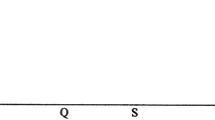Abstract
Much of the evidence provided in support of the argument that mathematical knowing is embodied/enacted is based on the analysis of gestures and bodily configurations, and, to a lesser extent, on certain vocal features (e.g., prosody). However, there are dimensions involved in the emergence of mathematical knowing and the production of mathematical communication that have not yet been investigated. The purpose of this article is to theorize one of these dimensions, which we call incarnate sonorous consciousness. Drawing on microanalyses of two exemplary episodes in which a group of third graders are sorting geometric solids, we show how sound has the potential to mark mathematical similarities and distinctions. These “audible” similarities and distinctions, which may be produced by incarnate dimensions such as beat gestures and prosody, allow children to objectify certain geometrical properties of the objects with which they transact. Moreover, the analysis shows that sonorous production is intertwined with other dimensions of students’ bodily activity. These findings are interpreted according to the “theory of mathematics in the flesh,” an alternative to current embodiment/enactivist theories in mathematics education.








Similar content being viewed by others
References
Bamberger, J., & diSessa, A. (2003). Music as embodied mathematics: A study of a mutually informing affinity. International Journal of Computers for Mathematical Learning, 8, 123–160.
Collins, R. (2004). Interaction ritual chains. Princeton: Princeton University Press.
Davis, B. (1997). Listening for differences: An evolving conception of mathematics teaching. Journal for Research in Mathematics Education, 28, 355–376.
Gregory, R. L. (1994). Even odder perceptions. London: Routledge.
Heidegger, M. (1977). Sein und Zeit [Being and time]. Tübingen: Max Niemeyer. First published in 1927.
Henry, M. (1965). Philosophie et phénoménologie du corps: Essai sur l’ontologie biranienne [Philosophy and phenomenology of the body: Essay on the ontology of Biran]. Paris: Presses Universitaires de France.
Henry, M. (2000). Incarnation: Une philosophie de la chair [Incarnation: A philosophy of the flesh]. Paris: Seuil.
Kieren, T., & Simmt, E. (2009). Brought forth in bringing forth: The inter-actions and products of a collective learning system. Complicity: An International Journal of Complexity and Education, 6(2), 20–28.
Lakoff, G., & Johnson, M. (1999). Philosophy in the flesh: The embodied mind and its challenge to western thought. New York: Basic Books.
Lakoff, G., & Núñez, R. (2000). Where mathematics comes from: How the embodied mind brings mathematics into being. New York: Basic Books.
Luria, A. R. (1973). The working brain. Harmondsworth: Penguin Books.
Maine de Biran. (2000). Mémoire sur la décomposition de la pensée [Essay on the decomposition of thought]. Paris: Librairie Philosophique J. Vrin.
Merleau-Ponty, M. (1945). Phénoménologie de la perception [Phenomenology of perception]. Paris: Gallimard.
Merleau-Ponty, M. (1964). Le visible et l’invisible [The visible and the invisible]. Paris: Gallimard.
Nancy, J.-L. (2007). Listening (C. Mandell, Trans.). New York: Fordham University Press.
Radford, L. (2009). Why do gestures matter? Sensuous cognition and the palpability of mathematical meanings. Educational Studies in Mathematics, 70, 111–126.
Radford, L., Bardini, C., & Sabena, C. (2007). Perceiving the general: The multisemiotic dimension of students’ algebraic activity. Journal for Research in Mathematics Education, 38, 507–530.
Radford, L., Edwards, L., & Arzarello, F. (2009). Introduction: Beyond words. Educational Studies in Mathematics, 70, 91–95.
Roth, W.-M. (2010). Incarnation: Radicalizing the embodiment of mathematics. For the Learning of Mathematics, 30(2), 8–17.
Roth, W.-M. (2011a). Passibility: At the limits of the constructivist metaphor. Dordrecht: Springer.
Roth, W.-M. (2011b). Researching living/lived mathematics. Forum Qualitative Sozialforschung/Forum Qualitative Social Research, 12(1). Retrieved April 7, 2011, from http://www.qualitative-research.net/index.php/fqs/issue/current.
Roth, W.-M. (2011c). The origins of geometry as objective science in elementary classrooms: Mathematics in the flesh. New York: Routledge.
Roth, W.-M., & Lawless, D. (2002). Signs, deixis, and the emergence of scientific explanations. Semiotica, 138, 95–130.
Roth, W.-M., & Thom, J. S. (2009). Bodily experience and mathematical conceptions: from classical views to a phenomenological reconceptualization. Educational Studies in Mathematics, 70, 175–189.
Sheets-Johnstone, M. (2009). The corporeal turn: An interdisciplinary reader. Exeter: Imprint Academic.
Steffe, L. P., & Thompson, P. W. (2000). Interaction or intersubjectivity? A reply to Lerman. Journal for Research in Mathematics Education, 31, 191–209.
Thom, J. S., & Roth, W.-M. (2011). Radical embodiment and semiotics: Toward a theory of mathematics in the flesh. Educational Studies in Mathematics. Published online: 19 February, 2011. doi: 10.1007/s10649-010-9293-y.
Vygotsky, L. S. (1986). Thought and language. Cambridge: MIT.
Acknowledgements
This research project was supported by a grant from the Social Sciences and Humanities Research Council of Canada (J. S. Thom, PI; W.-M. Roth, co-PI). We are grateful to Jean-François Maheux, who helped us in the data collection, to the three students and to their teachers who took part in this research project. We wish to thank the associate editor and three anonymous reviewers for their insightful comments on previous versions of this article.
Author information
Authors and Affiliations
Corresponding author
Rights and permissions
About this article
Cite this article
Bautista, A., Roth, WM. Conceptualizing sound as a form of incarnate mathematical consciousness. Educ Stud Math 79, 41–59 (2012). https://doi.org/10.1007/s10649-011-9337-y
Published:
Issue Date:
DOI: https://doi.org/10.1007/s10649-011-9337-y




